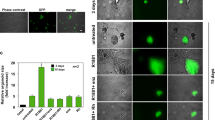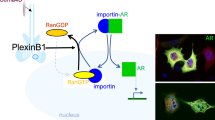Abstract
Prostate tumors are initially dependent on androgens for growth, but the majority of patients treated with anti-androgen therapy progress to androgen-independence characterized by resistance to such treatment. This study investigates a novel role for filamin A (FlnA), a 280 kDa cytoskeletal protein (consisting of an actin-binding domain (ABD) followed by 24 sequential repeats), in androgen-independent (AI) growth. Full-length FlnA is cleaved to 170 kDa (ABD+FlnA1–15) and 110 kDa fragments (FlnA16–24); the latter is further cleaved to a 90 kDa fragment (repeats 16–23) capable of nuclear translocation and androgen receptor (AR) binding. Here, we demonstrate that in androgen-dependent LNCaP prostate cancer cells, the cleaved 90 kDa fragment is localized to the nucleus, whereas in its AI subline C4–2, FlnA failed to cleave and remained cytoplasmic. Transfection of FlnA16–24 cDNA in C4–2 cells restored expression and nuclear localization of 90 kDa FlnA. Unlike LNCaP, C4–2 cells proliferate in androgen-reduced medium and in the presence of the AR-antagonist Casodex. They also exhibit increased Akt phosphorylation compared to LNCaP, which may contribute to their AI phenotype. Nuclear expression of 90 kDa FlnA in C4–2 cells decreased Akt phosphorylation, prevented proliferation in androgen-reduced medium and restored Casodex sensitivity. This effect was inhibited by constitutive activation of Akt indicating that FlnA restored Casodex sensitivity in C4–2 cells by decreasing Akt phosphorylation. In addition, FlnA-specific siRNA which depleted FlnA levels, but not control siRNA, induced resistance to Casodex in LNCaP cells. Our results demonstrate that expression of nuclear FlnA is necessary for androgen dependence in these cells.
This is a preview of subscription content, access via your institution
Access options
Subscribe to this journal
Receive 50 print issues and online access
$259.00 per year
only $5.18 per issue
Buy this article
- Purchase on Springer Link
- Instant access to full article PDF
Prices may be subject to local taxes which are calculated during checkout







Similar content being viewed by others
References
Anilkumar G, Rajasekaran SA, Wang S, Hankinson O, Bander NH, Rajasekaran AK . (2003). Prostate-specific membrane antigen association with filamin A modulates its internalization and NAALADase activity. Cancer Res 63: 2645–2648.
Barry CP, Xie J, Lemmon V, Young AP . (1993). Molecular characterization of a multi-promoter gene encoding a chicken filamin protein. J Biol Chem 268: 25577–25586.
Browne KA, Johnstone RW, Jans DA, Trapani JA . (2000). Filamin (280-kDa actin-binding protein) is a caspase substrate and is also cleaved directly by the cytotoxic T lymphocyte protease granzyme B during apoptosis. J Biol Chem 275: 39262–39266.
Culig Z, Hoffmann J, Erdel M, Eder IE, Hobisch A, Hittmair A et al. (1999). Switch from antagonist to agonist of the androgen receptor bicalutamide is associated with prostate tumour progression in a new model system. Br J Cancer 81: 242–251.
Culig Z, Klocker H, Bartsch G, Steiner H, Hobisch A . (2003). Androgen receptors in prostate cancer. J Urol 170: 1363–1369.
Dingwall C, Laskey RA . (1991). Nuclear targeting sequences – a consensus? Trends Biochem Sci 16: 478–481.
Feldman BJ, Feldman D . (2001). The development of androgen-independent prostate cancer. Nat Rev Cancer 1: 34–45.
Ghosh A, Wang X, Klein E, Heston WD . (2005a). Novel role of prostate-specific membrane antigen in suppressing prostate cancer invasiveness. Cancer Res 65: 727–731.
Ghosh PM, Bedolla R, Mikhailova M, Kreisberg JI . (2002). RhoA-dependent murine prostate cancer cell proliferation and apoptosis: role of protein kinase Czeta. Cancer Res 62: 2630–2636.
Ghosh PM, Malik S, Bedolla R, Kreisberg JI . (2003). Akt in prostate cancer: possible role in androgen-independence. Curr Drug Metab 4: 487–496.
Ghosh PM, Malik SN, Bedolla RG, Wang Y, Mikhailova M, Prihoda TJ et al. (2005b). Signal transduction pathways in androgen-dependent and -independent prostate cancer cell proliferation. Endocr Relat Cancer 12: 119–134.
Ghosh PM, Mikhailova M, Bedolla R, Kreisberg JI . (2001). Arginine vasopressin stimulates mesangial cell proliferation by activating the epidermal growth factor receptor. Am J Physiol Renal Physiol 280: F972–F979.
Gorlin JB, Yamin R, Egan S, Stewart M, Stossel TP, Kwiatkowski DJ et al. (1990). Human endothelial actin-binding protein (ABP-280, nonmuscle filamin): a molecular leaf spring. J Cell Biol 111: 1089–1105.
Graff JR, Konicek BW, McNulty AM, Wang Z, Houck K, Allen S et al. (2000). Increased AKT activity contributes to prostate cancer progression by dramatically accelerating prostate tumor growth and diminishing p27Kip1 expression. J Biol Chem 275: 24500–24505.
Hara T, Miyazaki J, Araki H, Yamaoka M, Kanzaki N, Kusaka M et al. (2003). Novel mutations of androgen receptor: a possible mechanism of bicalutamide withdrawal syndrome. Cancer Res 63: 149–153.
Heisler LE, Evangelou A, Lew AM, Trachtenberg J, Elsholtz HP, Brown TJ . (1997). Androgen-dependent cell cycle arrest and apoptotic death in PC-3 prostatic cell cultures expressing a full-length human androgen receptor. Mol Cell Endocrinol 126: 59–73.
Hsieh JT, Wu HC, Gleave ME, von Eschenbach AC, Chung LW . (1993). Autocrine regulation of prostate-specific antigen gene expression in a human prostatic cancer (LNCaP) subline. Cancer Res 53: 2852–2857.
Isaacs JT . (2000). Apoptosis: translating theory to therapy for prostate cancer. J Natl Cancer Inst 92: 1367–1369.
Jay D, Garcia EJ, de la Luz Ibarra M . (2004). In situ determination of a PKA phosphorylation site in the C-terminal region of filamin. Mol Cell Biochem 260: 49–53.
Jay D, Garcia EJ, Lara JE, Medina MA, de la Luz Ibarra M . (2000). Determination of a cAMP-dependent protein kinase phosphorylation site in the C-terminal region of human endothelial actin-binding protein. Arch Biochem Biophys 377: 80–84.
Jenster G, van der Korput JA, Trapman J, Brinkmann AO . (1992). Functional domains of the human androgen receptor. J Steroid Biochem Mol Biol 41: 671–675.
Kreisberg JI, Malik SN, Prihoda TJ, Bedolla RG, Troyer DA, Kreisberg S et al. (2004). Phosphorylation of Akt (Ser473) is an excellent predictor of poor clinical outcome in prostate cancer. Cancer Res 64: 5232–5236.
Loy CJ, Sim KS, Yong EL . (2003). Filamin-A fragment localizes to the nucleus to regulate androgen receptor and coactivator functions. Proc Natl Acad Sci USA 100: 4562–4567.
Malik SN, Brattain M, Ghosh PM, Troyer DA, Prihoda T, Bedolla R et al. (2002). Immunohistochemical demonstration of phospho-Akt in high Gleason grade prostate cancer. Clin Cancer Res 8: 1168–1171.
Manin M, Baron S, Goossens K, Beaudoin C, Jean C, Veyssiere G et al. (2002). Androgen receptor expression is regulated by the phosphoinositide 3-kinase/Akt pathway in normal and tumoral epithelial cells. Biochem J 366: 729–736.
Masiello D, Cheng S, Bubley GJ, Lu ML, Balk SP . (2002). Bicalutamide functions as an androgen receptor antagonist by assembly of a transcriptionally inactive receptor. J Biol Chem 277: 26321–26326.
Murray JT, Campbell DG, Peggie M, Alfonso M, Cohen P . (2004). Identification of filamin C as a new physiological substrate of PKBalpha using KESTREL. Biochem J 384: 489–494.
Ozanne DM, Brady ME, Cook S, Gaughan L, Neal DE, Robson CN . (2000). Androgen receptor nuclear translocation is facilitated by the f-actin cross-linking protein filamin. Mol Endocrinol 14: 1618–1626.
Robertson SP, Twigg SR, Sutherland-Smith AJ, Biancalana V, Gorlin RJ, Horn D et al. (2003). Localized mutations in the gene encoding the cytoskeletal protein filamin A cause diverse malformations in humans. Nat Genet 33: 487–491.
Shi XB, Ma AH, Tepper CG, Xia L, Gregg JP, Gandour-Edwards R et al. (2004). Molecular alterations associated with LNCaP cell progression to androgen independence. Prostate 60: 257–271.
Tepper CG, Boucher DL, Ryan PE, Ma AH, Xia L, Lee LF et al. (2002). Characterization of a novel androgen receptor mutation in a relapsed CWR22 prostate cancer xenograft and cell line. Cancer Res 62: 6606–6614.
Thomas P, Bossan A, Lacour JP, Chanalet S, Ortonne JP, Chatel M . (1996). Ehlers-Danlos syndrome with subependymal periventricular heterotopias. Neurology 46: 1165–1167.
Tigges U, Koch B, Wissing J, Jockusch BM, Ziegler WH . (2003). The F-actin cross-linking and focal adhesion protein filamin A is a ligand and in vivo substrate for protein kinase C alpha. J Biol Chem 278: 23561–23569.
van der Flier A, Sonnenberg A . (2001). Structural and functional aspects of filamins. Biochim Biophys Acta 1538: 99–117.
Wen Y, Hu MC, Makino K, Spohn B, Bartholomeusz G, Yan DH et al. (2000). HER-2/neu promotes androgen-independent survival and growth of prostate cancer cells through the Akt pathway. Cancer Res 60: 6841–6845.
Woo MS, Ohta Y, Rabinovitz I, Stossel TP, Blenis J . (2004). Ribosomal S6 kinase (RSK) regulates phosphorylation of filamin A on an important regulatory site. Mol Cell Biol 24: 3025–3035.
Wu HC, Hsieh JT, Gleave ME, Brown NM, Pathak S, Chung LW . (1994). Derivation of androgen-independent human LNCaP prostatic cancer cell sublines: role of bone stromal cells. Int J Cancer 57: 406–412.
Acknowledgements
We thank Dr Barry Furr, AstraZeneca, Cheshire, UK, for the gift of bicalutamide (Casodex), Drs Chong Jin Loy and Eu Leong Yong, National University of Singapore, Singapore, for the gifts of pCMV-FlnA(16–24) and pCMV-FlnA(1–15) plasmids; Dr Thomas Franke, Columbia University, New York, NY, USA, for pCMV-6-myr-Akt-HA and pCMV-6-Akt-K179 M plasmids; Dr Bandana Chatterjee, University of Texas Health Science Center at San Antonio (UTHSCSA) for hPSA-luc construct; Dr AO Brinkmann, Erasmus University, The Netherlands, for wild-type AR (pARO), Dr LuZhe Sun, UTHSCSA, for LNAI tumors and cell lines and Drs Clifford G Tepper and Maria Mudryj, University of California, Davis, for CWR22 and 22Rv1 tumors. This work was supported by a Merit award from the Department of Veterans Affairs and award CA109057 from the National Cancer Institute.
Author information
Authors and Affiliations
Corresponding author
Additional information
Supplementary Information accompanies the paper on the Oncogene Web site (http://www.nature.com/onc).
Supplementary information
Rights and permissions
About this article
Cite this article
Wang, Y., Kreisberg, J., Bedolla, R. et al. A 90 kDa fragment of filamin A promotes Casodex-induced growth inhibition in Casodex-resistant androgen receptor positive C4-2 prostate cancer cells. Oncogene 26, 6061–6070 (2007). https://doi.org/10.1038/sj.onc.1210435
Received:
Revised:
Accepted:
Published:
Issue Date:
DOI: https://doi.org/10.1038/sj.onc.1210435
Keywords
This article is cited by
-
Filamin A cooperates with the androgen receptor in preventing skeletal muscle senescence
Cell Death Discovery (2023)
-
The androgen receptor/filamin A complex as a target in prostate cancer microenvironment
Cell Death & Disease (2021)
-
The nuclear receptor HNF4 drives a brush border gene program conserved across murine intestine, kidney, and embryonic yolk sac
Nature Communications (2021)
-
Filamin A: Insights into its Exact Role in Cancers
Pathology & Oncology Research (2016)
-
Androgen receptor signaling in prostate cancer
Cancer and Metastasis Reviews (2014)



